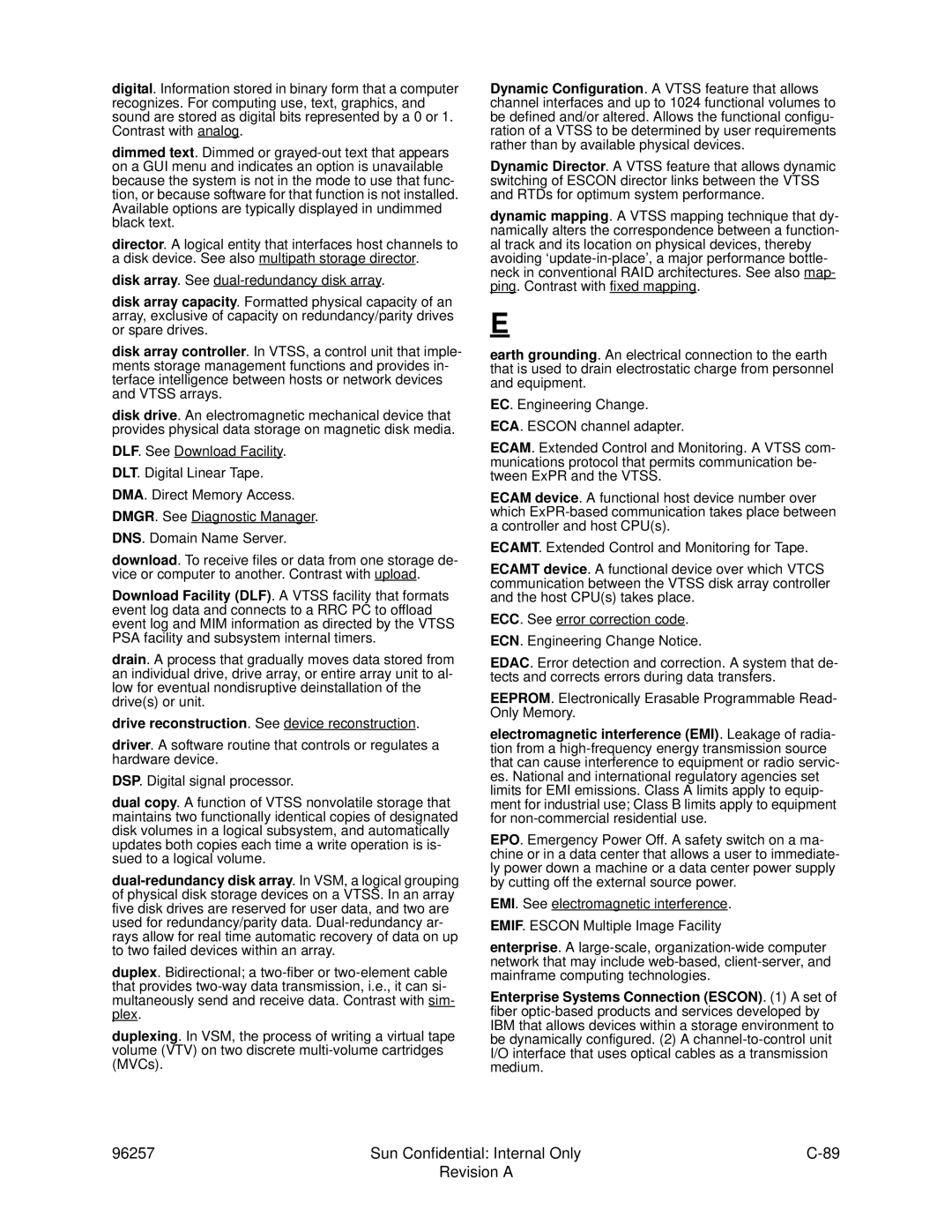digital. Information stored in binary form that a computer recognizes. For computing use, text, graphics, and sound are stored as digital bits represented by a 0 or 1. Contrast with analog.
dimmed text. Dimmed or
director. A logical entity that interfaces host channels to a disk device. See also multipath storage director.
disk array. See
disk array capacity. Formatted physical capacity of an array, exclusive of capacity on redundancy/parity drives or spare drives.
disk array controller. In VTSS, a control unit that imple- ments storage management functions and provides in- terface intelligence between hosts or network devices and VTSS arrays.
disk drive. An electromagnetic mechanical device that provides physical data storage on magnetic disk media.
DLF. See Download Facility.
DLT. Digital Linear Tape.
DMA. Direct Memory Access.
DMGR. See Diagnostic Manager.
DNS. Domain Name Server.
download. To receive files or data from one storage de- vice or computer to another. Contrast with upload.
Download Facility (DLF). A VTSS facility that formats event log data and connects to a RRC PC to offload event log and MIM information as directed by the VTSS PSA facility and subsystem internal timers.
drain. A process that gradually moves data stored from an individual drive, drive array, or entire array unit to al- low for eventual nondisruptive deinstallation of the drive(s) or unit.
drive reconstruction. See device reconstruction.
driver. A software routine that controls or regulates a hardware device.
DSP. Digital signal processor.
dual copy. A function of VTSS nonvolatile storage that maintains two functionally identical copies of designated disk volumes in a logical subsystem, and automatically updates both copies each time a write operation is is- sued to a logical volume.
duplex. Bidirectional; a
duplexing. In VSM, the process of writing a virtual tape volume (VTV) on two discrete
Dynamic Configuration. A VTSS feature that allows channel interfaces and up to 1024 functional volumes to be defined and/or altered. Allows the functional configu- ration of a VTSS to be determined by user requirements rather than by available physical devices.
Dynamic Director. A VTSS feature that allows dynamic switching of ESCON director links between the VTSS and RTDs for optimum system performance.
dynamic mapping. A VTSS mapping technique that dy- namically alters the correspondence between a function- al track and its location on physical devices, thereby avoiding
E
earth grounding. An electrical connection to the earth that is used to drain electrostatic charge from personnel and equipment.
EC. Engineering Change. ECA. ESCON channel adapter.
ECAM. Extended Control and Monitoring. A VTSS com- munications protocol that permits communication be- tween ExPR and the VTSS.
ECAM device. A functional host device number over which
ECAMT. Extended Control and Monitoring for Tape.
ECAMT device. A functional device over which VTCS communication between the VTSS disk array controller and the host CPU(s) takes place.
ECC. See error correction code.
ECN. Engineering Change Notice.
EDAC. Error detection and correction. A system that de- tects and corrects errors during data transfers.
EEPROM. Electronically Erasable Programmable Read- Only Memory.
electromagnetic interference (EMI). Leakage of radia- tion from a
EPO. Emergency Power Off. A safety switch on a ma- chine or in a data center that allows a user to immediate- ly power down a machine or a data center power supply by cutting off the external source power.
EMI. See electromagnetic interference.
EMIF. ESCON Multiple Image Facility
enterprise. A
Enterprise Systems Connection (ESCON). (1) A set of fiber
96257 | Sun Confidential: Internal Only | |
| Revision A |
|
